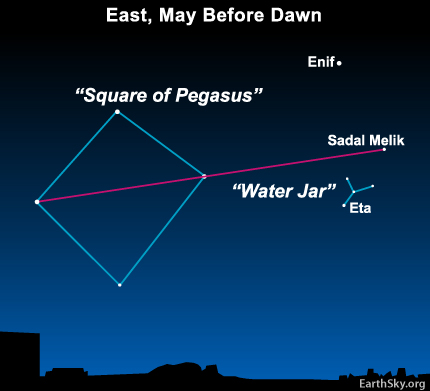
Image at top: Eta Aquariid meteors over the Atacama Desert in 2015, via Yuri Beletsky.
Before dawn these next several mornings – May 4, 5 and 6, 2019 – watch for meteors in the annual Eta Aquariid meteor shower to streak across the heavens in an inky dark sky unmarred by moonlight. We expect the morning of May 5 to showcase the peak number of meteors. But try the mornings before and after as well, as this meteor shower has a relatively broad peak.
Although the shower can be seen from all parts of Earth, the Eta Aquariids are especially fine from Earth’s Southern Hemisphere, and from the more southerly latitudes in the Northern Hemisphere. Appreciably north of 40 degrees north latitude (the latitude of Denver, Colorado; Beijing, China; and Madrid, Spain), the meteors are few and far between. The reason has to do with the time of twilight and sunrise on the various parts of Earth. To learn more, check this post on why more Eta Aquariid meteors are visible in the Southern Hemisphere.
It also helps to know that – as seen from all parts of Earth – the dark hour before dawn typically presents the greatest number of Eta Aquariid meteors.
Want to know when morning dawn first starts to light up your sky? Click here and remember to check the astronomical twilight box.
Eliot Herman in Tucson caught this meteor during 2017’s Eta Aquariid shower. He said: “… Got this meteor this morning, predawn, really predawn, just minutes before the light wiped out the camera.”
Like most meteors in annual showers, the Eta Aquariids are debris left behind by a comet, and, in this case, it’s a very famous comet indeed. Every year, as Earth passes through the orbital path of Comet Halley, bit and pieces shed by this comet burn up in the Earth’s atmosphere as Eta Aquariid meteors.
May 6, 2017 – Eta Aquariid captured at Mount Bromo (4K timelapse) from Justin Ng Photo on Vimeo.
Under ideal conditions, the Eta Aquariid meteor shower produces up to 20 to 40 meteors per hour. If you’re in the Southern Hemisphere, and you have a very dark sky, you might see that many since this year, in 2019, there is no moon to ruin the show.
And, as always for meteor-watching, be sure to avoid city lights …

You don’t need to find the radiant of the Eta Aquariid shower to watch this meteor shower. But if you’re interested in locating it, use the Great Square of Pegasus to star-hop to the radiant of the Eta Aquariid meteor shower. Read more.
Bottom line: In 2019, the Eta Aquariid meteor shower produces the most meteors before dawn on May 5 in inky dark skies unmarred by moonlight.
Read more: Where’s the radiant point for the Eta Aquariid meteor shower?
Read more: Everything you need to know: Eta Aquariid meteor shower
Read more: EarthSky’s meteor shower guide for 2019
from EarthSky http://bit.ly/2ZRtS5I

Image at top: Eta Aquariid meteors over the Atacama Desert in 2015, via Yuri Beletsky.
Before dawn these next several mornings – May 4, 5 and 6, 2019 – watch for meteors in the annual Eta Aquariid meteor shower to streak across the heavens in an inky dark sky unmarred by moonlight. We expect the morning of May 5 to showcase the peak number of meteors. But try the mornings before and after as well, as this meteor shower has a relatively broad peak.
Although the shower can be seen from all parts of Earth, the Eta Aquariids are especially fine from Earth’s Southern Hemisphere, and from the more southerly latitudes in the Northern Hemisphere. Appreciably north of 40 degrees north latitude (the latitude of Denver, Colorado; Beijing, China; and Madrid, Spain), the meteors are few and far between. The reason has to do with the time of twilight and sunrise on the various parts of Earth. To learn more, check this post on why more Eta Aquariid meteors are visible in the Southern Hemisphere.
It also helps to know that – as seen from all parts of Earth – the dark hour before dawn typically presents the greatest number of Eta Aquariid meteors.
Want to know when morning dawn first starts to light up your sky? Click here and remember to check the astronomical twilight box.
Eliot Herman in Tucson caught this meteor during 2017’s Eta Aquariid shower. He said: “… Got this meteor this morning, predawn, really predawn, just minutes before the light wiped out the camera.”
Like most meteors in annual showers, the Eta Aquariids are debris left behind by a comet, and, in this case, it’s a very famous comet indeed. Every year, as Earth passes through the orbital path of Comet Halley, bit and pieces shed by this comet burn up in the Earth’s atmosphere as Eta Aquariid meteors.
May 6, 2017 – Eta Aquariid captured at Mount Bromo (4K timelapse) from Justin Ng Photo on Vimeo.
Under ideal conditions, the Eta Aquariid meteor shower produces up to 20 to 40 meteors per hour. If you’re in the Southern Hemisphere, and you have a very dark sky, you might see that many since this year, in 2019, there is no moon to ruin the show.
And, as always for meteor-watching, be sure to avoid city lights …

You don’t need to find the radiant of the Eta Aquariid shower to watch this meteor shower. But if you’re interested in locating it, use the Great Square of Pegasus to star-hop to the radiant of the Eta Aquariid meteor shower. Read more.
Bottom line: In 2019, the Eta Aquariid meteor shower produces the most meteors before dawn on May 5 in inky dark skies unmarred by moonlight.
Read more: Where’s the radiant point for the Eta Aquariid meteor shower?
Read more: Everything you need to know: Eta Aquariid meteor shower
Read more: EarthSky’s meteor shower guide for 2019
from EarthSky http://bit.ly/2ZRtS5I

Aucun commentaire:
Enregistrer un commentaire